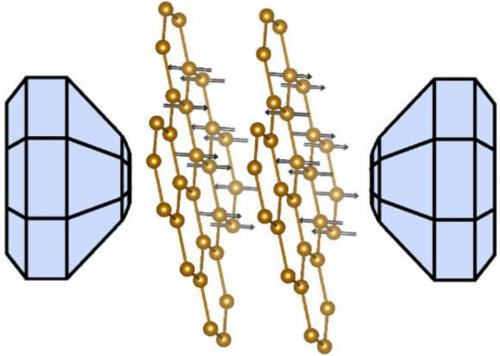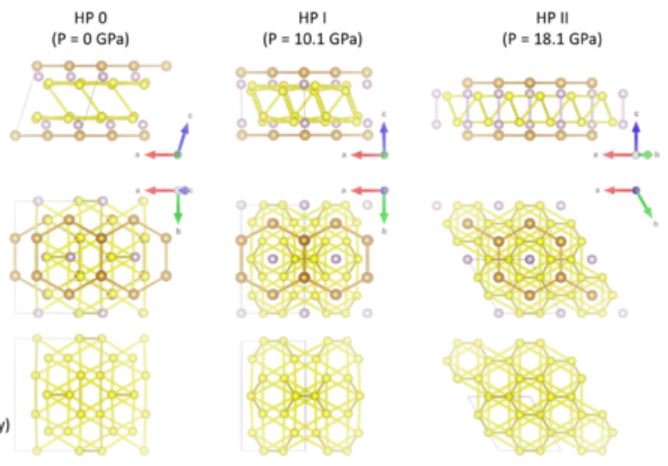
FePS3 , which scientists sometimes refer to as magnetic graphene, can switch from insulator to conductor, researchers found. The material’s ability to switch occurs under high pressure.
Scientists at the University of Cambridge believe this phenomenon has potential applications in next-generation electronics. It could also be used in the development of memory storage devices.
The researchers, from the University of Cambridge, Institut Laue-Langevin, and Diamond Light Source, wrote about their work in the prestigious journal Physical Review Letters (citation below). The authors were C. R. S. Haines, M. J. Coak, A. R. Wildes, G. I. Lampronti, C. Liu, P. Nahai-Williamson, H. Hamidov, D. Daisenberger, and S. S. Saxena.
The authors say that their findings will aid in understanding the dynamic relationship between the material’s structural and electronic properties. Magnetic graphene may represent a novel way to create 2-dimensional materials.
Researchers now viewing FePS3 differently
FePS3 (trithiohypophosphate) is from the van der Waals family of materials. Researchers first synthesized it in the 1960s.
Since one decade ago, however, scientists have started looking at FePS3 differently, i.e., with fresh eyes.
FePS3, similar to graphene – a 2D form of carbon – can be ‘exfoliated’ into ultra-thin layers. However, FePS3 is magnetic while graphene is not.
Spin
We refer to the expression for electrons’ intrinsic source of magnetism as ‘spin.’ Spin makes electrons behave in a similar way to a bar magnet and point in a specific way.
We use the magnetism from the arrangement of electronic spins in the majority of memory devices. It is important in the development of new technologies such as spintronics. It could completely change how computers process data.
The search for a magnetic graphene
Graphene is the strongest, lightest, and thinnest material in the world. It is also the world’s best conductor of heat and electricity.
Despite its amazing qualities, graphene is not magnetic. This limits its application in magnetic storage and spintronics.
Scientists have, therefore, been searching for a magnetic material which they could incorporate with graphene-based devices.
In this latest study, researchers squashed layers of trithiohypophosphate under high pressure – approximately 10 gigapascals. Under that pressure, the material switched between conductor and insulator, a phenomenon we call a Mott transition. They could also change its conductivity by altering the pressure.
According to a University of Cambridge press release:
“These materials are characterized by weak mechanical forces between the planes of their crystal structure. Under pressure, the planes are pressed together, gradually and controllable pushing the system from three to two dimensions, and from insulator to metal.”
“The researchers also found that even in two dimensions, the material retained its magnetism.”
Magnetism in two dimensions
First author, Dr Sebastian Haines, said:
“Magnetism in two dimensions is almost against the laws of physics due to the destabilizing effect of fluctuations, but in this material, it seems to be true.”
Dr. Haines is a Research Associate at Cambridge’s Department of Earth Sciences and Department of Physics.
The authors said that the materials are:
- Cheap
- Easy to synthesize
- Non-toxic
With further research, it would be possible to incorporate them into graphene-based devices.
Dr. Haines added:
“We are continuing to study these materials in order to build a solid theoretical understanding of their properties. This understanding will eventually underpin the engineering of devices, but we need good experimental clues in order to give the theory a good starting point.”
“Our work points to an exciting direction for producing two-dimensional materials with tuneable and conjoined electrical, magnetic and electronic properties.”
The Engineering and Physical Sciences Research Council (EPSRC) funded the study.
Citation
“Pressure-Induced Electronic and Structural Phase Evolution in the van der Waals Compound FePS3,” C. R. S. Haines, M. J. Coak, A. R. Wildes, G. I. Lampronti, C. Liu, P. Nahai-Williamson, H. Hamidov, D. Daisenberger, and S. S. Saxena. Physical Review Letters 121, 266801 – Published 28 December 2018. DOI: https://doi.org/10.1103/PhysRevLett.121.266801.

